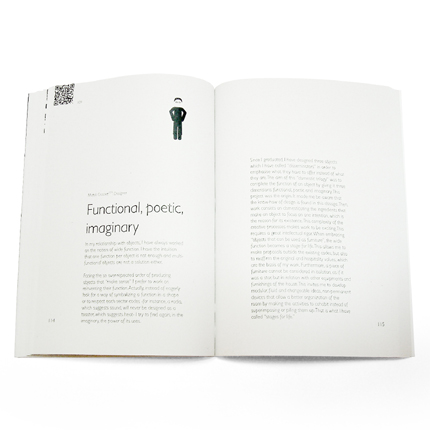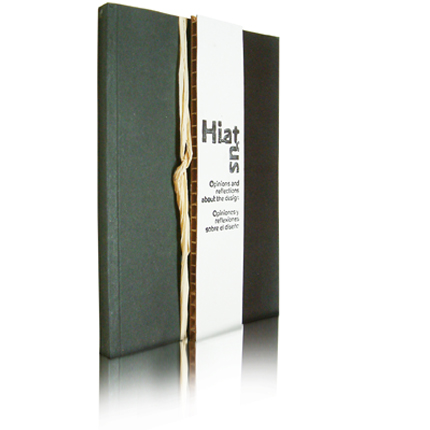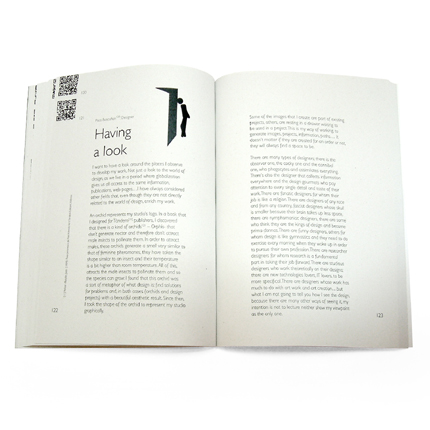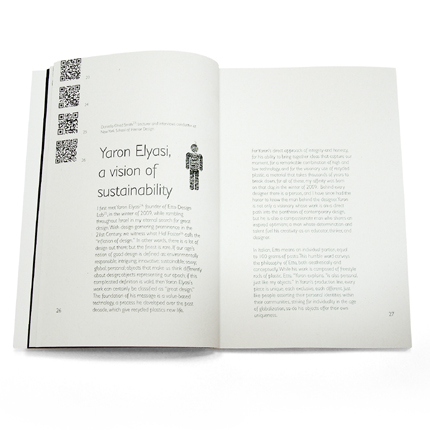01 Ago A Book that gathers together the reflections of twenty international designers and thinkers about innovations in the manofacturing process and sustainable development
Matali Crasset contribution to Hiatus vol.II
The second volume of Hiatus gathers together a score of personal opinions and reflections from the main international designers, who talk about the new way of understanding the innovations in the manufacturing process and sustainable development.
Ideas and thoughts from acclaimed creatives like Jorge Pensi or Matari Casset, design thinkers like Pierre Bernard or Ken Garland and people in charge of international organisations like Maria Amatullo, deputy chairwoman of Designmatters and Enzio Manzini, instigator of the Interdepartmental Centre for Research on Innovation for Sustainability, fill the pages of this book with unpublished texts and revised and updated manifestos. They tackle form the influence of social design in countries like Lebanon or Palestine to projects in developing regions; even the concept “social design” is questioned.
In fact, Hiatus is an object-book, conceived as an example of eco-design, which aim is to make society know the personal motivations of the designers and analysts that will define the spaces and products we will live with in the future; as explained by Ana Yago, director of Sanserif Creatius and coordinator of the publication.
Hiatus vol.II · Sanserif Creatius
Altogether, 24 professionals from 10 different countries tackle questions such us the election between autonomous or systematic designs, the importance of the bicycles in a new social-technological ecosystem, or the evolution of the Palestinian scarf (Keffiyeh) and its social connotations.
The professionals from the first volume, Jasper Morrison, Li Edelkoot and Nacho Carbonell among others, get together with –in addition to the aforementioned- Aart van Bezooyen, Keiko Hirano, Jamie Derringuer or the Valencians Sanserif Creatius and Paco Bascuñán, whose collaboration has taken the shape of a posthumous article about the ways of understanding the creative process through the knowledge of the everyday things and the cultural references.
Paco bascuñán contribution to Hiatus vol.II
Repair before recycling. Another of the outstanding aspects of this volume is the presentation of the updating of some of the manifestos that have ruled the evolution of design in the last decades: the First Thing First Manifesto (1964), by Ken Garnald, and its review in 2002; or the Hannover Principles (2000), by William McDonough and Michael Braungart, that gather together some assertions about design and its environmental impact, its effect on the sustainable growth and its global impact on society.
Furthermore, it includes new ways of understanding social design, like that defended by Joanna van der Zanden and Platform21, which is to say, the Repair Manifesto, a compilation of proposals to reduce the substitution of objects in order to promote reuse, for the same use or a similar one. A declaration of intent that includes unpublished notes from Gabriel Oropallo, that try to develop this manifesto and adapt it to the designer’s process.
This way, in the second volume of Hiatus, we highlight the collaboration of the president of the Associacione Italiana Design della Comunicazione Visiva (AIAP), Daniela Piscitelli, who makes a revision of sensitive communication; or the profile made by the professor and analyst of New York School of Interior Design, Daniela Ohad Smith, about Yaron Elyasi, as the referent of the new eco-design. Without forgetting the criticism brought by Gabriele Pezzini and Jaime Derringer, executive editor of the online magazine Design Milk; and different approaches of the influence of design in society and the environment by Patty Johnson, Warren berger, Hala A.Malak, Paula Raché and the professor of design history at the University of Illinois Chicago, Victor Margolin, that complete the line-up of Hiatus II.
Daniella Ohad Smith contributiob to vol.II
All the articles come with a BIDI code that allows the reader to have additional information about the authors, their work and all the references in the text, from literature to monuments, studies, projects or pieces that explain the content. The aim is to make this book a documentary source book, and not just a text. Thus, regardless the place where you are reading the text, the information it contains can be set in a context by using a mobile phone or a tablet, according to the creative director of Sanserif Creatius.
In addition, Ana Yago has told us that this collection will have a sequel, a third volume exclusively about fashion design and accessories, where we will find Spanish fashion designers such us Roberto Verino or Francis Montesinos, international needles such us Lie Sang Bong, Jum Nakao and Tim Van Steenbergen, among others; in addition to pioneers in eco-fashion like Marci Zaroff or John Patrick, and critics like Marion Hume.
Both publications are part of the Essencia project by Sanserif Creatius, finalists of the 2012 National Crafts Awards, and has been printed on recycled paper distributed by Torraspapel Distribución, which, in addition to preserve the forests, it helps to reduce the use of natural resources –water, energy, etc.- and the CO2 emissions to the atmosphere. More precisely, the paper used was Cyclus Print 115 g/m for the inside and Falconboard 6mm for the covers.
More info at @Hiatusbookblog or http://hiatusbookblog.wordpress.com





